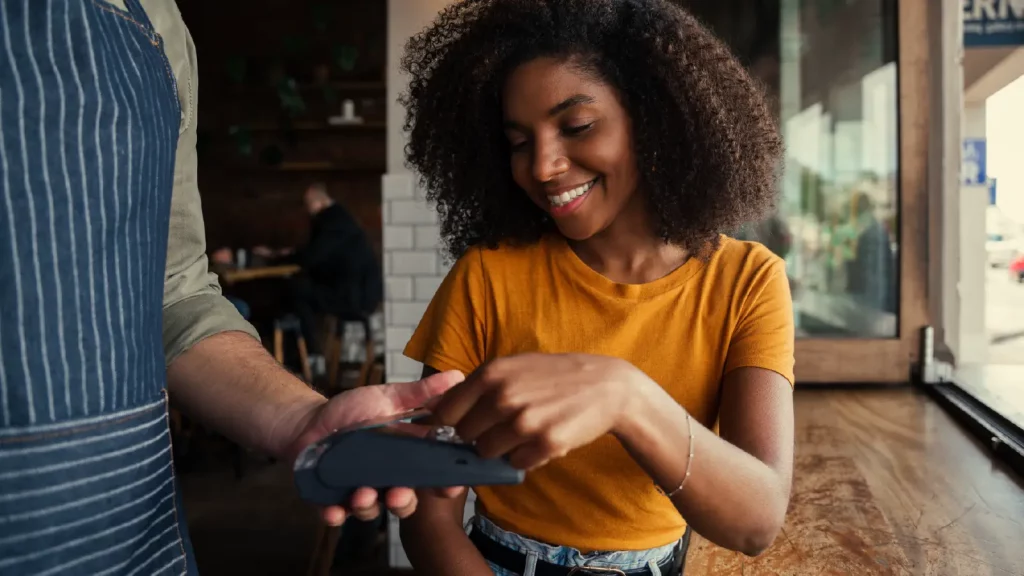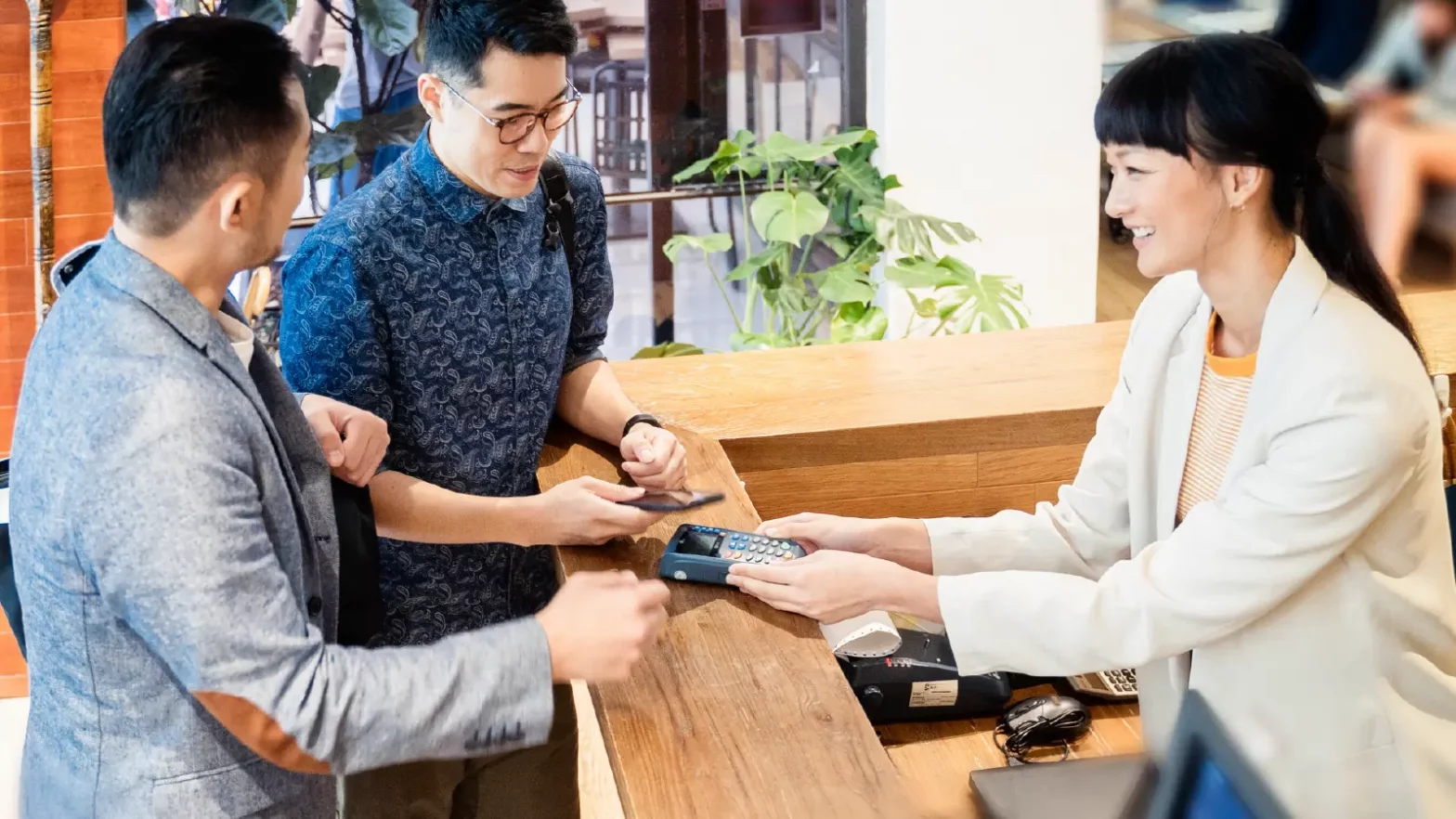It’s not just retailers paving the way for contactless payments anymore. From travel and hospitality to casinos and gaming, nearly every industry is focusing on touchless commerce solutions. Let’s look at how we got here and why contactless payment technology is becoming table stakes for these industries rather than optional features.
The Surprising History of Contactless Payments
How long do you think contactless payments have been around? Since the onset of the pandemic? Five years? A decade? Wrong!
This fast-growing technology first appeared in the U.S. in 1997 when Mobil offered Speedpass — an electronic system that allowed customers to pay for gas with a special key fob — at participating gas stations. At the same time, Coca-Cola in Helsinki rolled out a vending machine that allowed users to pay for their beverage with an SMS message via a mobile account linked to a user’s device.
Today, contactless payments are used by thousands of national chains, small businesses, banks, and credit card companies worldwide. And while the widespread adoption was inevitable, the momentum it gained was accelerated by the COVID-19 pandemic.
For instance, the pre-pandemic U.S. mobile and contactless payment adoption rate was about 10% —far below global levels. And now, according to CFPB analysts, it’s estimated that digital wallet tap-to-pay transactions will grow by over 150% by 2028. We’re seeing consumers prefer tap-and-go payment methods and mobile wallets such as Apple Pay, Google Pay, and Samsung Pay at an accelerated rate.
It’s pretty clear that contactless payments is a technology that’s here to stay, so let’s take a closer look at how this next-gen payment trend works.
Contactless Payments: Secure, Efficient, and Effortless
According to Visa, a contactless payment is a transaction made by tapping a contactless card or payment-enabled mobile or wearable device over a contactless-enabled payment terminal.
This type of touchless technology is a secure way to purchase products or services using Radio Frequency Identification (RFID) or Near-Field Communication (NFC) technology. It is also referred to as “tap-and-go” by some banks and retailers for its swift communication that doesn’t require the consumer to enter a PIN or insert an EMV chip card. Yet, it relies on the same type of secure payment technology: tokenization.
As the trailblazer of payment tokenization, this is something that we know a thing or two about. Simply put, tokenization is the process of replacing sensitive data — such as a consumer’s Personal Account Number (PAN) — into a random string of characters called a token. The token has no meaningful value if the merchant’s system is breached by data thieves. The actual cardholder data is secured off-site — often via encryption — in a token vault database, which stores the relationship between the sensitive value and the randomized token.
Knowing how secure and efficient contactless payments are, it’s easy to understand why consumers have come to expect touch-free payments anywhere they do business.

Contactless Payments Are Everywhere You Are
Five or 10 years ago, contactless payment options were only seen at large retailers or hip hospitality locales — even then, it was a rare sighting. Today, this consumer option is readily available for every industry and merchants of all sizes — including small business mom-and-pop shops.
Here’s a look at how various industries use touch-free payment methods to enhance the overall consumer experience.
Travel & Hospitality
Hotels can leverage contactless payments during check-in and check-out, and guests can often simply let the hotel know they’ve arrived via an app. A mobile room key can be generated and the entire process can be completed without any face-to-face contact.
And don’t forget about getting to the hotel. Many airlines, including Allegiant, are becoming completely cashless and rolling out contactless payment solutions for everything from ticket sales to in-flight purchases.
Food & Beverage
Contactless payments are being leveraged by restaurants and bars as a way to help guests and staff stay (and feel) safe. By implementing this technology, customers can pay without handing their card over, resulting in a faster and more secure transaction compared to traditional methods. These touch-free payments can include contactless terminals as well as QR code ordering and payments.
Sports & Entertainment
Even large venues are getting in on the contactless strategy to create a better experience for fans. After all, if you’re attending a sporting event or concert for a few hours, you don’t want to spend half your time waiting in line for a beverage and missing all the action.
Chicago’s United Center, home to the NBA’s Bulls and the NHL’s Blackhawks, understands this pain point and recently implemented contactless payment solutions as part of their mission to enhance the in-venue fan experience. Transactions for everything from concessions, premiums, suites, and retail has been streamlined to help provide fans with a consistent, seamless interaction.
Gaming
Like any industry, gaming needs to embrace contactless payments if it wants to continue to grow. Enabling payment choices on the casino floor does more than provide consumer flexibility. It also provides an unmatched and secure online gaming and sports-betting platform via an advanced payment platform, including live virtual casino floor games, daily and weekly poker tournaments, and a sportsbook interface.
Retail
Contactless payments are omnipresent in retail. Leveraging this technology allows retailers to focus on curbside pickup, which increased over 200% during the COVID-19 pandemic. Contactless payments reduce transaction time, shorten lines, and bring peace of mind to shoppers and employees wanting to avoid direct contact whenever possible.
Contactless Payments Are the Future
These contactless payment methods aren’t just a passing fad — they have proven to be a technology that benefits businesses and consumers alike. And while we may never become a fully fledged, cashless society, we are certainly inching closer every day.
